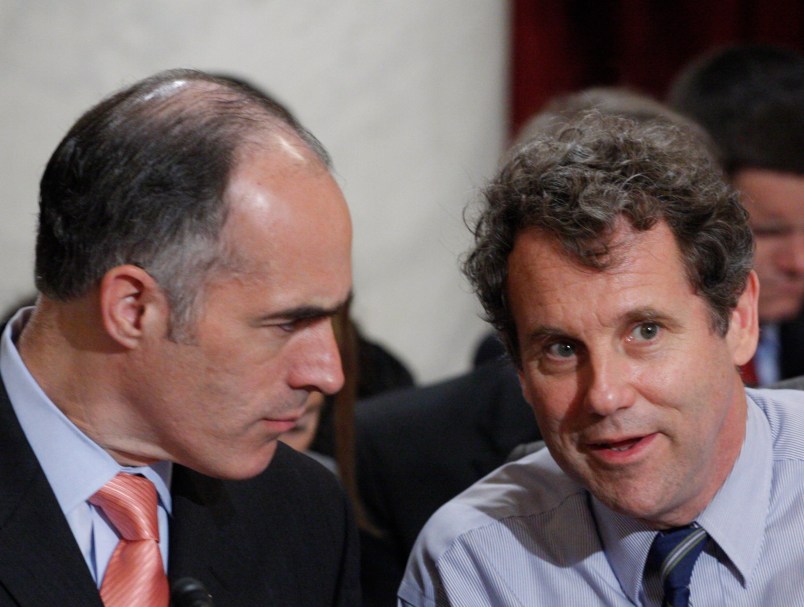Rising income inequality has damaged Social Security’s fiscal health, and progressives believe that addressing it could go a long way toward improving the program’s long-term outlook.
That’s the primary finding in a new report from the liberal Center for American Progress, which was provided exclusively to TPM on Tuesday. The report lands as a renewed fight over Social Security is bubbling up in the new Congress.
Last month, House Republicans passed a rule that blocks a revenue transfer between the retirement and disability funds, the latter of which is projected to be unable to pay full benefits starting late 2016, unless the program’s overall solvency is improved. Conservative wonks have said they hope Congress uses the opportunity to change the program more broadly, and some House GOP leaders have signaled that they’ll give it a try.
Democrats have been warning that means benefit cuts or even another privatization attempt, and the new CAP analysis should be seen as a counterpoint to whatever Republicans propose. Its findings suggest that collecting more money from the rich and raising wages for lower income brackets will put the program on the right track. No benefit cuts or substantive changes like individual accounts or privatization would be necessary.
“I think this points out a real problem and a real threat to Social Security that hasn’t been addressed,” Sen. Bob Casey (D-PA), who sits on Senate Finance’s Social Security subcommitee, told TPM in a phone interview. “Often, all we hear about in Washington is how some on the other side of the aisle want to either privatize Social Security or cut benefits. If anything, we need to strengthen the program, and this direct linkage between income inequality and the adverse impact that the middle class has had to endure is a big problem. We have to deal with it.”
It also helps put the Social Security debate in a broader income inequality and middle-class growth debate, which has become favored territory for Democrats over the last few years and heading into the 2016 presidential election. Hillary Clinton is expected to center her presidential campaign’s economic message around those issues.
“A real economic growth strategy, a real middle-class economics, will do a bunch of things. It puts people to work. It means incomes go up. It means that the budget deficit comes down,” Sen. Sherrod Brown (D-OH), ranking member of the Social Security subcommittee, told TPM in a phone interview. “And most importantly, it means money for Social Security will grow faster.”
“I think we’re already winning the debate,” he continued, “and I think this will be another compelling story for the American public as we debate this issue.”
Here is the argument that CAP puts forward. Social Security puts a cap on income that can be taxed; in 2015, that cap is $118,500. Any income that somebody makes above that threshold is not subject to Social Security taxes.
So, as income equality stratified and the wealthy accumulated more money above that cap, the share of Americans’ income being taxed for Social Security has decreased from 90 percent in 1983 to 83 percent in 2013. CAP estimated that, if the share had stayed at 90 percent, Social Security would have $1.1 trillion more in its coffers.
The other piece of CAP’s puzzle is stagnant wages for the middle and lower classes. American workers are more productive, but wage growth hasn’t caught up. They are therefore paying less money into Social Security; if wages had kept up with productivity over the last 30 years, CAP estimates that Social Security would have brought in an additional $759 billion over that time.
The report isn’t specific about what should be done, but its implications seem obvious. Social Security currently has a projected $11.1 trillion shortfall over the next 75 years, the preferred timeline for assessing the program’s solvency. CAP estimates that if the program was able to again capture 90 percent of wages starting in 2015, it would close that shortfall by 27 percent. Increasing wages for average workers would also bolster the program.
Senate Democrats will soon introduce a bill with specific proposals building off the CAP report, Brown told TPM. But the catch is that it would likely include new revenue, which is almost certainly a non-starter for the Republicans who are in control on Capitol Hill.
Brown expressed optimism that his colleagues across the aisle could be convinced to make a deal– but if they can’t, he thinks framing Social Security as a broader income inequality issue will pay political dividends for Democrats.
“The history says that the more the public finds out about the Republican position on Social Security, the more we win,” he said. “Our hope is always, sure, win the political debate for the next election. That of course is a byproduct, but what really matters is to win the debate so that the public begins to understand the contrast between the two and push the Republicans to do the right thing here.”










Increase the maximum Social Security Taxable Earnings cap from the current $118,500 to $250,000.
Problem solved forever.
Remove the salary cap in its entirety. Only reason it is there is for rich people.
The top 0.1% should be taxed half their income, including cap gains and inheritance. Business regulations should be no weaker than the worst corporate excesses. It’s the only way to keep the top from taking over.
Dabbling around the edges might shore up SS (on paper) but it won’t stop fascist buffoonery.
I have another proposed idea that should be looked at. Make the amount of social security benefits that is taxed move with the payroll tax cap. If a person has income above the payroll tax cap than their benefit should be taxed in full. If a person has less than the current payroll tax cap in income than their benefit should not be taxed. Use the amount paid in taxes on social security benefits to roll it back into the social security program. Currently, if you have above $35,000 in total income you get taxed on social security income above that level. It seems to me that I recall the amount paid into FICA was already taxed initially.
“So, as income equality stratified and the wealthy accumulated more money above that cap, the share of Americans’ income being taxed for Social Security has decreased from 90 percent in 1983 to 83 percent in 2013. CAP estimated that, if the share had stayed at 90 percent, Social Security would have $1.1 trillion more in its coffers.”
Which suggests that the very first fix is to temporarily readjust the FICA limit to recapture that missing 7% until the income inequality itself can be worked out.
“all we hear about in Washington is how some on the other side of the aisle want to either privatize Social Security or cut benefits”
That’s because those are the only “solutions” the MSM wants to allow Amurikkkans to think exist. Let’s be real here: even those that pander to “liberals” like MSNBC are still huge corporations with hundreds or thousands of employees to whom they desperately do not want to give raises.